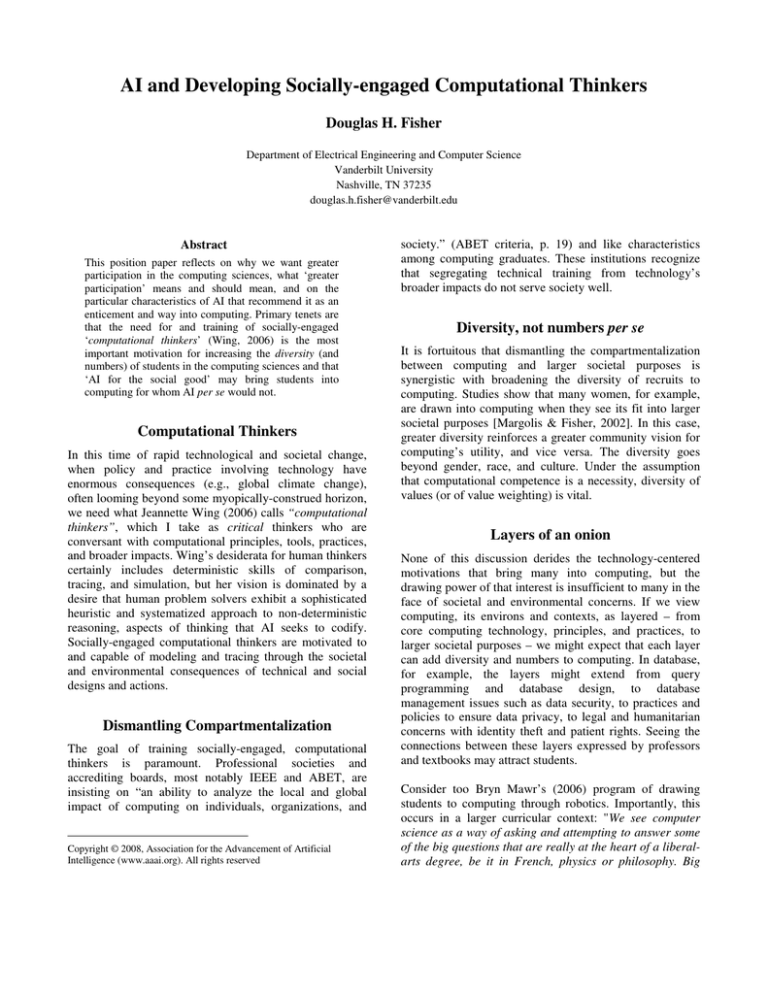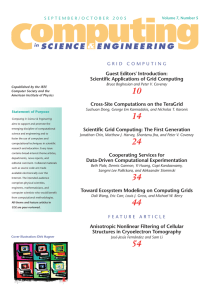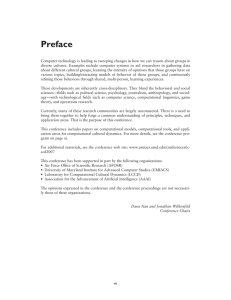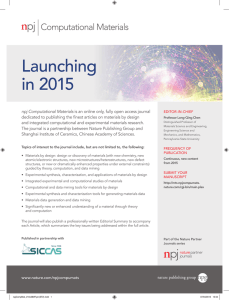
AI and Developing Socially-engaged Computational Thinkers
Douglas H. Fisher
Department of Electrical Engineering and Computer Science
Vanderbilt University
Nashville, TN 37235
douglas.h.fisher@vanderbilt.edu
Abstract
This position paper reflects on why we want greater
participation in the computing sciences, what ‘greater
participation’ means and should mean, and on the
particular characteristics of AI that recommend it as an
enticement and way into computing. Primary tenets are
that the need for and training of socially-engaged
‘computational thinkers’ (Wing, 2006) is the most
important motivation for increasing the diversity (and
numbers) of students in the computing sciences and that
‘AI for the social good’ may bring students into
computing for whom AI per se would not.
Computational Thinkers
In this time of rapid technological and societal change,
when policy and practice involving technology have
enormous consequences (e.g., global climate change),
often looming beyond some myopically-construed horizon,
we need what Jeannette Wing (2006) calls “computational
thinkers”, which I take as critical thinkers who are
conversant with computational principles, tools, practices,
and broader impacts. Wing’s desiderata for human thinkers
certainly includes deterministic skills of comparison,
tracing, and simulation, but her vision is dominated by a
desire that human problem solvers exhibit a sophisticated
heuristic and systematized approach to non-deterministic
reasoning, aspects of thinking that AI seeks to codify.
Socially-engaged computational thinkers are motivated to
and capable of modeling and tracing through the societal
and environmental consequences of technical and social
designs and actions.
Dismantling Compartmentalization
The goal of training socially-engaged, computational
thinkers is paramount. Professional societies and
accrediting boards, most notably IEEE and ABET, are
insisting on “an ability to analyze the local and global
impact of computing on individuals, organizations, and
Copyright © 2008, Association for the Advancement of Artificial
Intelligence (www.aaai.org). All rights reserved
society.” (ABET criteria, p. 19) and like characteristics
among computing graduates. These institutions recognize
that segregating technical training from technology’s
broader impacts do not serve society well.
Diversity, not numbers per se
It is fortuitous that dismantling the compartmentalization
between computing and larger societal purposes is
synergistic with broadening the diversity of recruits to
computing. Studies show that many women, for example,
are drawn into computing when they see its fit into larger
societal purposes [Margolis & Fisher, 2002]. In this case,
greater diversity reinforces a greater community vision for
computing’s utility, and vice versa. The diversity goes
beyond gender, race, and culture. Under the assumption
that computational competence is a necessity, diversity of
values (or of value weighting) is vital.
Layers of an onion
None of this discussion derides the technology-centered
motivations that bring many into computing, but the
drawing power of that interest is insufficient to many in the
face of societal and environmental concerns. If we view
computing, its environs and contexts, as layered – from
core computing technology, principles, and practices, to
larger societal purposes – we might expect that each layer
can add diversity and numbers to computing. In database,
for example, the layers might extend from query
programming and database design, to database
management issues such as data security, to practices and
policies to ensure data privacy, to legal and humanitarian
concerns with identity theft and patient rights. Seeing the
connections between these layers expressed by professors
and textbooks may attract students.
Consider too Bryn Mawr’s (2006) program of drawing
students to computing through robotics. Importantly, this
occurs in a larger curricular context: "We see computer
science as a way of asking and attempting to answer some
of the big questions that are really at the heart of a liberalarts degree, be it in French, physics or philosophy. Big
questions such as: Who are we? Where have we come
from? What is consciousness?" (Douglas Blank, Bryn
Mawr, 2006). Robotics may have an additive attraction
over “core computing”, but larger context and purpose
(e.g., the many forms of human-assistive robotics) may
have further attraction.
Guarding against bait and switch
Playing a computer game is a different activity than
creating and building one. We should understand in some
deep sense what it is about gaming, for example, that
draws the interest of prospective, competent computer
scientists. We should assess any recruiting strategy at
varying intervals and design advanced coursework in ways
that are informed by initial recruiting strategies;
maintenance is at least as important as initial recruiting. A
concern with focusing primarily on ‘fun’ in designing
gateways into computing is the significant possibility of
bait-and-switch. Analogous possibilities presumably exist
with socially-embedded introductions into computing,
though once instilled in students, such enticements may
translate to more persistent motivations that are resistant to
students’ feelings of bait-and-switch.
Why AI?
My interest in AI as a gateway into computing is not about
numbers of students per se, but of developing sociallyengaged computational thinkers. Many if not all areas of
computing (e.g., database, software engineering, algorithm
theory) can be productive bridges. Moreover, areas
mentioned in the Symposium’s call such as robotics, need
not involve any substantive AI at all, yet still be a draw
(e.g., they exercise particular forms of creativity and/or
appeals to naïve anthropomorphism). Other referenced
areas that might involve AI, such as computational biology
and computational economics, are contextualized by social
utilities, which confounds crediting AI with the drawing
power – social utility is a draw.
What is special about AI is that it codifies complex and
nondeterministic aspects of thought and its study addresses
two important facets of computational thinking. First, it
requires study and practice of computational principles,
tools, etc. Second, AI can be used to illustrate, convey, and
exercise the critical thinking skills that we want in humans.
Existing programs of study in critical thinking are
concerned with the processes targeted by AI: “Many of our
students will find themselves in careers that will require
them to be decision makers and they will need to reason
their way through various dilemmas in an uncertain and
complex world. A number of thinking skills, including the
abilities to consider options, predict consequences,
determine the reliability of information, and think about
causality, are crucial to reasoning one’s way to a good
decision” (Tufts University, Critical Thinking Program).
As such, these programs may be good sources of ideas for
using AI as a medium for developing computational
thinkers, including the importance of computational
thinking in societal contexts (e.g., University of
Massachusetts, Boston, Critical and Creative Thinking
Program).
Conclusion
This position paper presumes that an interest in numbers is
secondary to an interest in developing computational
thinkers. Beyond some of the details, the paper asks that
the Symposium organizers and participants consider
questions: Why do we want “greater participation” in
computer science? What does “greater participation”
mean? What might confound an evaluation of AI as a
bridge to computing?
Acknowledgements
This paper stems from the author’s experience as a
Vanderbilt University faculty member and additional
thoughts while serving at and supported by the National
Science Foundation. Any opinion, findings, and
conclusions or recommendations expressed in this position
paper are those of the author and do not necessarily reflect
the views of the National Science Foundation.
References
ABET criteria. Criteria for Accrediting Computing
Programs 2007-2008 Criteria.
http://www.abet.org/forms.shtml#For_Computing_Progra
ms_Only.
Bryn Mawr (2006). http://www.brynmawr.edu/news/200607-13/robotics.shtml
Margolis, J., & Fisher, A. (2002). Unlocking the
Clubhouse. The MIT Press, Cambridge, MA.
Tufts University, Critical Thinking Program.
http://ase.tufts.edu/criticalThinking/workshop.asp
University of Massachusetts, Boston, Critical and Creative
Thinking Program.
http://www.cct.umb.edu/homepage.html
Wing, J. (2006). Computational Thinking.
Communications of the ACM, 49, 3, 33-35.






